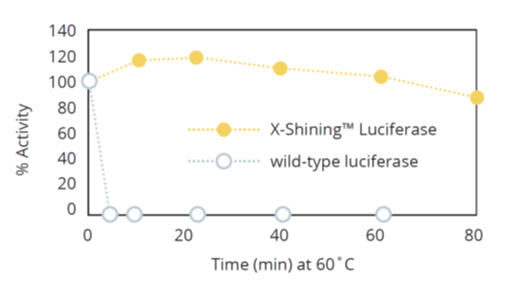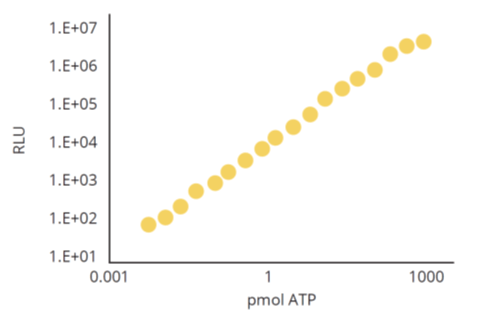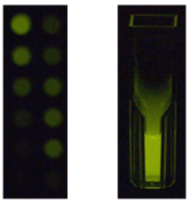Thermostable luciferase for sensitive microbiology assays
Modified thermostable X-Shining™ Luciferase allows sensitive bioluminescent environmental monitoring, ATP testing and bacterial identification in microbial assays.
Biosynth Carbosynth’s modified thermostable X-Shining™ Luciferase is perfectly suitable for any luciferin-luciferase-based assay using D-luciferin (dLuc) or synthetic pro-luciferins (caged luciferins). Examples of its typical applications include ATP tests in hygiene monitoring, ATP tests in drug screenings and bacteria identification in microbial assays. This robust luciferase has been optimised by genetic engineering for strongly increased thermostability and storage stability. X-Shining™ Luciferase is supplied as lyophilised (BX180145) or as an aqueous solution with glycerol (BX174908). Highly stable, it may be kept for months at room temperature without significant loss of function.
Outstanding thermal stability
In temperature stress tests, the enzyme survives temperatures of 60°C for over an hour, whereas a normal luciferase from firefly is inactivated after only a few minutes. This makes it user-friendly and eliminates some of the main disadvantages and limitations of the commonly used wild-type luciferases. By combining genetic engineering, protein over-expression and purification techniques, we produce a >90% pure luciferase enzyme that is more cost effective than even wild-type.

Applications
1) ATP assays
Adenosine triphosphate (ATP) is present in all living cells and plays a central role in energy balance. The intracellular concentration of ATP is tightly regulated and is maintained at a similar level in all cells. When a cell dies, the ATP is completely degraded; ATP levels therefore reflect the presence of any living cell. The bioluminescence-based assays are extremely sensitive; a standard luminometer can detect as little as 0.1 picomole of ATP.

2) Enzyme activity assays
Luciferase bioluminescence can also be used for ultra-sensitive detection of a broad range of enzymatic activities, using D-luciferin or aminoluciferin coupled with enzyme labile groups such as substrates. Luciferin-based substrates have been referred to as “caged luciferins” or “pro-luciferins” in literature. Pro-luciferins can be used for example for the detection of specific groups of bacteria, for reporter gene assays in animal cells or plant biology.

You can find out more about Biosynth’s X-Shining™ Luciferase here.

 Find products for your research
Find products for your research